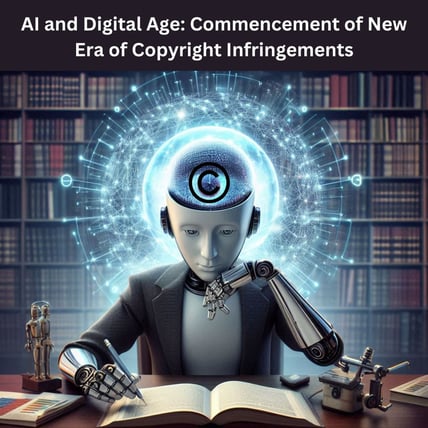AI and Digital Age: Commencement of New Era of Copyright Infringements
Deepanshi
Indian Institute of Management Rohtak
This Article is written by Deepanshi, a Third-year law student of Indian Institute of Management Rohtak


Assigning copyright ownership to AI under the Indian Copyright Act hinges on whether AI can be considered an author. According to the law, ownership belongs to the work's author. This presents a challenge, as defining authorship is straightforward when dealing with a human creator but becomes complex when it involves AI-generated content. AI has rapidly advanced and now influences nearly every aspect of human life, with its primary aim being to augment human abilities. AI operates through machine learning, analyzing patterns and data to replicate them. Although designed to mimic human behavior, AI differs fundamentally from humans, leading to disputes over authorship and intellectual property rights across various legal systems.
The Indian Copyright Act of 1957, specifically Section 2(d)(vi), addresses this by stating that for computer-generated works, "the person who causes the work to be created" is considered the author. In this context, the individual most directly involved in the creation process holds the copyright. This usually means that the person who finances and takes the risk of creating AI-generated work owns the copyright, not the end user, as their contribution is minimal. Software developers, who are typically hired to create the AI, also do not retain ownership. Copyright protects the expression of ideas, not the ideas themselves, so if a copyright is infringed, the owner bears responsibility.
Although there are no legal precedents for AI-generated works, the inclusion of this provision suggests a possible broader interpretation of authorship to include AI. However, the traditional goal of copyright laws—to reward authors for their creative expressions—becomes complicated with AI involvement. Assigning authorship to AI is difficult because Indian law traditionally recognizes only natural persons as creators. For instance, Section 22 of the Copyright Act defines the duration of copyright based on the creator's lifetime, clearly indicating that the law was designed with human creators in mind.
Section 51 of the Copyright Act addresses copyright infringement but does not yet consider AI-generated content, leaving limited scope for including AI under this legislation. As countries consider integrating AI into copyright law, it is crucial to consider how these changes would align with the core principles of copyright, like the "sweat of the brow" doctrine, which holds that the person who invests effort and labor into creating a work is the rightful author. Artists often oppose granting AI ownership of intellectual property, arguing that this would undermine their incentives and stifle creativity.
Section 13 of the Copyright Act, 1957 emphasizes the importance of originality for copyright protection in India. The work need not be novel, but it must originate from the author. Divergent opinions exist on what constitutes originality, with two key doctrines— "sweat of the brow" and "modicum of creativity"—guiding judicial interpretation. The Supreme Court has stressed the "modicum of creativity" in its interpretation of originality under Section 13, as seen in the Eastern Book Company v. D.B. Modakxxi case. This raises questions about whether AI-generated content can meet the originality criteria required for copyright protection, though neither the judiciary nor the legislature in India has addressed this issue.
Indian jurisprudence needs to evaluate the extent to which AI challenges existing intellectual property laws. Arguably, India's current regulations might allow for the transfer of copyright ownership involving AI if interpreted more broadly. However, careful consideration of the potential consequences is necessary before implementing such changes. As this area of law is still emerging, further research into the ethical and economic implications of AI and its rights is essential. Considering that the Indian Constitution extends fundamental rights to "persons" and that robots like Sophia could be granted citizenship in the future, India's legal framework must evolve in recognizing intellectual property rights beyond human creativity. Additionally, with intellectual property increasingly being used as business assets, incorporating AI into the scope of intellectual property rights has become essential.
References
Agarwal, Saakshi. “The Dilemma of Copyright Law and Artificial Intelligence in India.” Search eLibrary: SSRN, 6 April 2021, https://papers.ssrn.com/sol3/papers.cfm?abstract_id=3818280. Accessed 7 September 2024.
Bharwani, Anushka. “Eastern Book Company and Ors. vs D.B. Modak and Ors.” Law Times Journal, 8 October 2020, https://lawtimesjournal.in/eastern-book-company-and-ors-vs-d-b-modak-and-ors/. Accessed 7 September 2024.
C, Hemavathy. “Intellectual Property Rights and Copyright Laws in the Regime of Artificial Intelligence (AI) in India.” Library Philosophy and Practice; Lincoln, 2024, pp. 1-11, https://www.proquest.com/scholarly-journals/intellectual-property-rights-copyright-laws/docview/3062727075/se-2?accountid=133056.
“Climbing towards NLU: On Meaning, Form, and Understanding in the Age of Data.” ACL Anthology, https://aclanthology.org/2020.acl-main.463/. Accessed 7 September 2024.
“Everything You Need To Know About Sophia, The World's First Robot Citizen.” Forbes, 7 November 2017, https://www.forbes.com/sites/zarastone/2017/11/07/everything-you-need-to-know-about-sophia-the-worlds-first-robot-citizen/. Accessed 7 September 2024.
“Feist Publications, Inc. v. Rural Tel. Serv. Co., 499 U.S. 340 (1991).” Justia U.S. Supreme Court Center, https://supreme.justia.com/cases/federal/us/499/340/. Accessed 7 September 2024.
Moran, Brent, and Brigitte Vézina. “Artificial Intelligence and Creativity: Why We're Against Copyright Protection for AI-Generated Output.” Creative Commons, 10 August 2020, https://creativecommons.org/2020/08/10/no-copyright-protection-for-ai-generated-output/. Accessed 7 September 2024.
